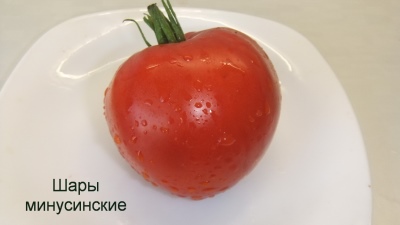
- Authors: Russia, Minusinsk
- Growth type: indeterminate
- Appointment: fresh consumption, for juice
- Ripening period: mid-season
- Growing conditions: for greenhouses
- Bush size: tall
- Bush height, cm: 180
- Ripe fruit color: red with pink tint
- Fruit shape: heart-shaped, round, slightly ribbed
- Fruit weight, g: 200
Among the tomatoes of Siberian origin, the Minusinsk varieties stand apart. The unique climate of the Minusinsk Basin has created ideal conditions for growing tomatoes, despite the northern region. The indeterminate variety Minusinskie Shara is intended for cultivation in all types of greenhouses, in private and private farms. Ripe fruits are used for fresh food, sliced and in summer and winter salads, for cooking juices and sauces, for making tomato paste.
Breeding history
The variety was bred by folk breeders of the Russian city of Minusinsk and its environs.
Description of the variety
Tall (180 cm and more) medium leafy bushes are covered with dark green foliage of medium size, typical tomato size, with a pronounced odor. The shoots are rather fragile and weak - so that the bush can withstand the weight of heavy fruits, gardeners have to tie up not only the stems, but also the brushes. To obtain a large berry, it is necessary to apply the formation and pinching of the plant.
Advantage of Minusinski balls:
- large-fruited;
- resistance to cracking;
- versatility of cultivation;
- dessert taste and variety in use;
- rich in vitamins and minerals.
Disadvantages:
- the need for pinning and shaping;
- poor resistance to extreme weather conditions.
The leaf blade has a weak, barely noticeable pubescence, shallow dissection. The yellow flowers are collected in simple inflorescences that form clusters with 3-4 berries.
The main qualities of the fruit
Green in an immature state, slightly ribbed large (200 g and more) fruits change color to a beautiful pink-red hue.
Taste characteristics
The berry of Minusinsk balls is characterized by increased sugar content. The sweet, low-seeded fleshy pulp looks like sugar at the break. The fruits are rich in vitamins (A, B, C, K) and trace elements (iodine, calcium, potassium). According to nutritionists, two tomatoes of this variety can fill the body's daily need for nutrients.
Ripening and fruiting
The plant belongs to the mid-ripening category of tomatoes. The variety has an extended fruiting, which allows you to feast on fresh berries for a long time.
Yield
Minusinsk balls are considered a high-yielding variety, but, like all large-fruited varieties, its performance depends entirely on compliance with the rules of agricultural technology. Up to 4 kg are harvested from one bush, sometimes more.
The timing of planting seedlings and planting in the ground
Like all Siberian tall tomatoes, Minusinsk balls are grown in seedlings. Sowing is carried out in late February - early March, 2.5-3 months before disembarking to a permanent place. The variety is planted in a greenhouse in May, in open ground - in June, after the end of return frosts.

Growing tomato seedlings is an extremely important process, because it largely depends on whether the gardener can harvest at all.All aspects must be taken into account, from seedbed preparation to planting in the ground.
Landing scheme
Tall large-sized carpets do not tolerate crowding, therefore no more than three roots are planted per square meter.

Growing and caring
Minusinsk balls are necessarily grown in a seedling way - it makes no sense to sow seeds into the ground, since they will have time to grow, but they will not be able to give a crop.
A place for permanent cultivation is prepared in advance. Tomato loves good lighting with light shading. The acidity level of the soil should be neutral or close to this indicator. The plant develops well in loose, breathable soil, rich in humus, organic matter, micro- and macroelements. In late autumn, manure is introduced into the ground, in the spring the ridges are enriched with humus, compost or bird droppings, complex mineral fertilizers and wood ash are added.
Supports are installed in the prepared holes, the planted seedlings are immediately tied up, the soil in the near-stem circle is compacted, well spilled with warm, settled water. The next day, the soil is loosened to provide oxygen to the roots.
Further care consists in timely watering, weeding, loosening or mulching, sanitizing. To obtain a good harvest, the bushes are formed into 1-2 stems. Grasshopping is obligatory, the lower leaves are removed completely after the appearance of the first brush. After the mass ripening of the berry begins, almost all the leaves are removed, directing the nutrients to the tomatoes.




A plant needs different micronutrients at each stage of growth. All fertilizers can be divided into two groups: mineral and organic. Folk remedies are often used: iodine, yeast, bird droppings, eggshells.
It is important to observe the rate and period of feeding. This also applies to folk remedies and organic fertilizers.
Disease and pest resistance
Minusinsk balls have a fairly strong immunity and successfully resist many diseases traditional for nightshades. The danger is top and root rot, as well as late blight and rust. Pests are even more dangerous for them:
- leaf-eating aphid;
- thrips, bear, spider mite;
- May and Colorado beetles, whitefly.
To ensure the healthy state of plants, preventive treatments with insecticides and fungicides are necessary.


Growing regions
Tomato, born in Siberian conditions, is intended primarily for cultivation in the Krasnoyarsk Territory, Tyumen, Irkutsk regions, as well as in the Urals, the Far East and warmer regions.

























































































